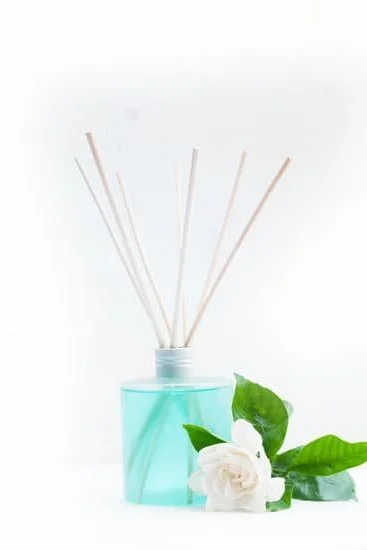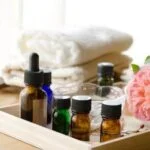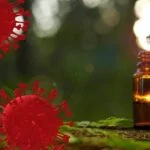Aromatherapy and essential oils have gained significant popularity in recent years, as more and more people seek natural remedies for their physical and mental well-being. But what exactly is the difference between aromatherapy and essential oils? In this article, we will explore the definitions of both practices, highlight their main differences, and delve into the benefits and methods of application for each.
Aromatherapy is a holistic healing technique that uses aromatic plant extracts, known as essential oils, to promote physical, emotional, and psychological well-being. These essential oils are highly potent substances that are extracted from various parts of plants such as flowers, leaves, stems, and roots. They capture the plant’s fragrance and chemical properties which can provide therapeutic effects when inhaled or applied to the skin.
Essential oils themselves are highly concentrated plant compounds that carry the characteristic scent of the source plant. They are obtained through various extraction methods such as steam distillation or cold pressing. The process involves carefully harvesting the plants at specific times to preserve their beneficial properties and extracting oil from these plants using specialized techniques.
Understanding the distinction between aromatherapy and essential oils is crucial for utilizing these natural remedies effectively. While aromatherapy refers to the practice or therapy itself, essential oils are the tools used in this practice. In the following sections of this article we will further explore their differences, benefits, methods of application, safety precautions, and how to choose high-quality products for optimal use.
With a clear understanding of what distinguishes aromatherapy from essential oils, you’ll be better equipped to unlock their therapeutic potential for overall well-being. So let’s dive into the world of aromatherapy and explore the fascinating benefits it offers when combined with high-quality essential oils.
Definition of Aromatherapy
Aromatherapy is a holistic healing practice that utilizes the therapeutic properties of essential oils to promote physical and mental well-being. It involves the use of aromatic plant extracts, known as essential oils, which are obtained from various parts of plants such as flowers, leaves, stems, bark, and seeds. These oils are highly concentrated and contain the natural fragrance and medicinal properties of the plant.
One key aspect of aromatherapy is its ability to stimulate the olfactory system, or sense of smell. When essential oils are inhaled, they interact with the sensory receptors in our nose and send signals to the limbic system in our brain. The limbic system plays a critical role in regulating emotions, memories, and physiological responses. Therefore, aromatherapy has a direct impact on our mood and emotions.
In addition to inhalation, aromatherapy can also be administered through topical application and diffusion. During topical application, diluted essential oils are applied directly to the skin through massage or other methods. This allows for their absorption into the bloodstream and provides localized benefits. Diffusion involves dispersing essential oils into the air using diffusers or vaporizers. This method allows for inhalation of the oils’ microscopic particles for respiratory benefits.
Aromatherapy works by harnessing the natural healing powers of plants through their essential oils. Each oil has unique therapeutic properties that can be used to address specific physical conditions or emotional states. For example, lavender essential oil is known for its calming effects on anxiety and promoting relaxation, while peppermint oil is commonly used for headaches and digestive issues.
Overall, aromatherapy offers a natural and holistic approach to improving overall well-being by using essential oils derived from plants. By understanding what aromatherapy is and how it works, individuals can make informed decisions about incorporating this practice into their self-care routines to enhance both physical health and emotional balance.
Definition of Essential Oils
What Are Essential Oils?
Essential oils are highly concentrated plant extracts that capture the natural fragrance and beneficial properties of the plant they are derived from. These oils are obtained through a process called steam distillation, which involves using heat or steam to separate the volatile compounds from the plant material. This method allows for the extraction of various aromatic molecules found in flowers, leaves, stems, bark, and other parts of plants.
The Process of Obtaining Essential Oils
To obtain essential oils, plants undergo a meticulous extraction process. First, the plant material is carefully selected and harvested at its peak to ensure the highest quality oil. Then, it goes through a process known as steam distillation. During this process, the plant material is exposed to gentle heat or steam in a distillation apparatus. The heat causes the plant cells to release their essential oil content, which evaporates along with the steam.
The steam and vapor flow into a condenser where they cool down and condense back into liquid form. At this stage, two distinct layers are formed – essential oil and water. The essential oil layer is then collected separately from the water layer, as it contains the volatile aromatic compounds responsible for its fragrance and therapeutic properties.
Additionally, certain delicate flowers can’t withstand high temperatures necessary for steam distillation. In such cases, a method called solvent extraction is used instead. Using solvents like hexane or ethanol, these flowers are gently soaked to dissolve their essential oil content. The resulting mixture is then filtered to remove any impurities before evaporating off the solvent to obtain pure essential oils.
Overall, by harnessing nature’s botanical essences through careful extraction methods, essential oils offer potent fragrances and therapeutic benefits that can enhance physical wellness and support emotional well-being when used correctly.
Main Differences
Aromatherapy and essential oils are often used interchangeably, but it is important to understand that they are not the same thing. While they are related and can be used together, there are some key differences between the two.
Firstly, aromatherapy refers to the use of aromatic plant extracts, including essential oils, to promote physical and mental well-being. It involves the utilization of scents and fragrances to stimulate the senses and evoke certain emotional or physical responses. Aromatherapy can be practiced using various methods such as diffusing oils in a room, inhaling them directly, or applying them topically.
On the other hand, essential oils are concentrated plant extracts derived from leaves, stems, flowers, or roots of plants through processes like steam distillation or cold-pressing. These oils capture the essence and aroma of the plant they come from. Essential oils have many different properties depending on their source plant and can be used for a range of purposes such as skincare, relaxation, or improving respiratory health.
One major difference between aromatherapy and essential oils is that aromatherapy is an approach or practice that incorporates essential oils as one of its main tools. It involves creating specific blends or combinations of essential oils to achieve certain therapeutic effects on both the body and mind. On the other hand, while essential oils can be used in aromatherapy, they also have many other applications outside of this practice.
It is important to remember that while essential oils are natural substances derived from plants, they are highly concentrated and potent. This means that they should always be used with caution and in accordance with proper guidelines to ensure safety and effectiveness. Aromatherapy provides a framework for using essential oils safely and effectively by incorporating them into a holistic approach towards well-being.
Benefits of Aromatherapy
Physical Benefits
Aromatherapy offers a wide range of physical benefits for those who use it. One of the most common uses is for pain relief, as certain essential oils have analgesic properties that can help alleviate muscle soreness, headaches, and joint pain. Lavender oil, for example, has been shown to reduce pain and inflammation when applied topically.
In addition to pain relief, aromatherapy can also promote better sleep. Many people struggle with insomnia or restless nights, but certain essential oils such as chamomile and lavender have calming properties that can help induce relaxation and improve sleep quality. By diffusing these oils into the air or adding them to a warm bath before bed, individuals can create a soothing atmosphere that promotes restful sleep.
Furthermore, aromatherapy has been found to support respiratory health. Essential oils like eucalyptus and peppermint have expectorant and decongestant properties that can help clear sinuses and relieve congestion. These oils can be diffused in the air or added to steam inhalation treatments to provide relief from respiratory issues such as colds, flu, or allergies.
Mental Benefits
Apart from its physical benefits, aromatherapy also offers numerous advantages for mental well-being. Aromatherapy has been shown to reduce stress and anxiety levels by promoting relaxation and increasing feelings of calmness. Essential oils like bergamot and ylang-ylang are known for their mood-enhancing properties and can be used to create a peaceful environment.
Additionally, aromatherapy is often used in holistic approaches to manage symptoms of depression. Certain essential oils have uplifting effects on mood and can help combat feelings of sadness or low energy levels. For example, citrus oils such as orange or lemon are commonly used for their antidepressant effects.
Moreover, aromatherapy has the potential to boost cognitive function. Some essential oils, such as rosemary and peppermint, have been linked to improved focus, concentration, and memory retention. By using these oils during work or study sessions, individuals can enhance their mental alertness and productivity.
Overall, the benefits of aromatherapy extend beyond physical relaxation and encompass mental well-being as well. Whether seeking relief from pain, better sleep quality, respiratory support, stress reduction, mood enhancement, or cognitive improvement, aromatherapy offers a holistic approach to achieving optimal health and wellness.
Benefits of Essential Oils
Essential oils have gained popularity in recent years due to their numerous health benefits. These oils are highly concentrated liquids that are extracted from plants through various methods such as steam distillation or cold-press extraction. One of the key advantages of essential oils is their versatility and ability to be used for a wide range of purposes, including skincare, relaxation, and respiratory health.
When it comes to skincare, essential oils have been found to offer several benefits. Many essential oils possess anti-inflammatory and antimicrobial properties that can help soothe and heal skin conditions such as acne, eczema, and psoriasis. For example, tea tree oil is known for its antibacterial properties and is commonly used to treat acne breakouts. Lavender oil, on the other hand, is renowned for its calming effects on the skin and can help reduce redness and irritation.
In terms of relaxation, essential oils have long been used in aromatherapy practices to promote a sense of calm and relaxation. Certain oils like lavender, chamomile, and bergamot have been found to have sedative effects on the nervous system, helping to alleviate stress, anxiety, and insomnia.
These oils can be diffused into the air through an oil diffuser or added to a warm bath for a soothing experience. In addition to their psychological effects on relaxation, some essential oils also have physical benefits such as reducing muscle tension and inflammation.
Another area where essential oils shine is in supporting respiratory health. Eucalyptus oil has been widely used to relieve congestion and promote clearer breathing in conditions such as colds, allergies, or sinusitis. Inhalation of this oil can help open up airways by reducing inflammation in the respiratory system. Peppermint oil is another favorite when it comes to respiratory health, as its cooling and decongestant properties can provide relief from nasal congestion and promote easier breathing.
Methods of Application
Aromatherapy and essential oils can be used in various ways to enjoy their therapeutic benefits. The methods of application provide different ways for the aroma and properties of the essential oils to be released into the air or absorbed by the body. The three main methods of application for aromatherapy and essential oils are diffusing, topical application, and inhalation.
Diffusing is a popular method that involves dispersing essential oils into the air. This can be done using a diffuser, which releases a fine mist that carries the aroma throughout a room. Diffusing not only creates a pleasant ambiance but also allows the aromatic molecules to enter the body through inhalation. This method is particularly effective for promoting relaxation, improving sleep quality, and purifying the air.
Topical application involves directly applying diluted essential oils onto the skin. Essential oils are highly concentrated and need to be diluted with a carrier oil before being applied topically to avoid skin irritation or sensitization.
When applied to the skin, essential oils can be absorbed through the pores and enter the bloodstream. This method is commonly used for various purposes such as skincare, massage therapy, relief from muscle pain or tension, and addressing specific health concerns like respiratory issues or insect bites.
Inhalation is another common method of using aromatherapy and essential oils. It involves breathing in aromatic molecules directly from an open bottle or by using personal inhalers or steam inhalation techniques.
Inhaling essential oils can have immediate effects on mood and emotions due to their ability to stimulate receptors in our olfactory system which is linked to our brain’s limbic system responsible for emotions and memory. Inhalation is often recommended for relieving stress, boosting focus and concentration, reducing symptoms of respiratory conditions like congestion or sinusitis, as well as supporting emotional well-being.
Overall, the methods of application for aromatherapy and essential oils offer flexibility for individuals to choose the most suitable way to enjoy the benefits. Whether it’s diffusing for creating a relaxing atmosphere, topical application for targeted effects on the body, or inhalation for quick emotional support, these methods allow individuals to incorporate aromatherapy into their daily routine in ways that best suit their lifestyle and preferences.
Safety and Precautions
When it comes to using aromatherapy and essential oils, it is important to be aware of the potential risks and precautions associated with their use. While these natural plant extracts can offer numerous benefits, they should also be used with caution to ensure optimal safety and effectiveness.
One key aspect to consider is the dilution guidelines for essential oils. Undiluted essential oils can be too potent and may cause adverse reactions such as skin irritation or sensitization. It is generally recommended to dilute essential oils with a carrier oil before applying them topically.
The appropriate dilution ratio will depend on factors like the individual’s age, skin sensitivity, and the purpose of use. For example, a 2% dilution (10-12 drops of essential oil per ounce of carrier oil) is commonly recommended for adults, while a lower dilution ratio may be suitable for children or individuals with sensitive skin.
Pregnant women should exercise additional caution when using aromatherapy and essential oils due to potential risks. Certain oils are known to have emmenagogue properties, which means they can stimulate menstrual flow or even induce labor. It is advised for pregnant women to consult with a healthcare professional before using any essential oils. Additionally, some oils are considered toxic during pregnancy or breastfeeding and should be avoided entirely.
| Essential Oil Dilution | Recommended Ratio |
|---|---|
| Adults | 2% (10-12 drops per ounce of carrier oil) |
| Children/Sensitive Skin | 1% or less (5-6 drops per ounce of carrier oil) |
It is crucial to prioritize safety and seek guidance when using aromatherapy and essential oils, especially if you have any underlying health conditions or are taking medications. Consulting with a qualified aromatherapist or healthcare professional can provide personalized advice based on your specific needs. By following the appropriate guidelines, you can effectively harness the therapeutic benefits of these natural remedies while minimizing potential risks and ensuring a safe experience.
Choosing the Right Products
When it comes to aromatherapy and essential oils, selecting the right products is crucial to ensure a safe and effective experience. With so many options available in the market, it can be overwhelming to know which ones to choose. However, by following some tips and guidelines, you can select high-quality aromatherapy products and essential oils with confidence.
Firstly, it is important to look for reputable brands that prioritize quality and purity. Check if the brand follows industry standards and has a transparent production process. Look for brands or suppliers that provide detailed information about their sourcing methods, extraction techniques, and any third-party testing they conduct. This information will give you confidence in the authenticity of their products.
Another factor to consider when choosing aromatherapy products or essential oils is the labeling. Genuine products will clearly label all ingredients used in the product. Avoid purchasing items with vague or general terms such as “fragrance oil” or “blend.” Instead, opt for products that list specific essential oils or carrier oils used. This way, you have a better understanding of what you are using on your body.
Additionally, take into account the packaging of the aromatherapy products or essential oils. Quality packaging should protect the product from heat, light, and air exposure – factors that can degrade its potency over time. Look for dark glass bottles instead of clear ones as they help prevent sunlight exposure.
Furthermore, consider reading customer reviews and testimonials before making a purchase. These can provide valuable insights into product quality, effectiveness, and customer satisfaction. Also, you may want to consult with an experienced aromatherapist or herbalist who can guide you in selecting the most suitable options based on your specific needs.
By following these tips and guidelines when choosing aromatherapy products and essential oils, you can ensure that you are getting high-quality, authentic, and safe products. Remember, the quality of the products you use directly affects their therapeutic benefits, so it is essential to make informed choices. With the right products in your arsenal, you can experience the full potential of aromatherapy and essential oils for your well-being.
Conclusion
In conclusion, it is important to understand the difference between aromatherapy and essential oils in order to fully harness their therapeutic benefits. Aromatherapy is the practice of using aromatic plant extracts to promote physical and mental well-being, while essential oils are highly concentrated oils obtained from plants that can be used for various purposes.
By understanding what aromatherapy is and how it works, individuals can make informed decisions about integrating this practice into their daily lives. Aromatherapy has been shown to have numerous benefits, including stress reduction, improved sleep quality, enhanced mood, and relief from certain ailments. It can be used through diffusing, topical application, or inhalation methods.
On the other hand, essential oils offer specific benefits for different purposes such as skincare, relaxation, and respiratory health. They can be added to beauty products or used in massage therapy to promote healthy skin and relaxation. Additionally, certain essential oils have properties that can support respiratory health by clearing congestion and soothing symptoms.
When using these products, it is crucial to follow safety guidelines and precautions. Dilution guidelines should always be followed when using essential oils topically to prevent skin irritation or sensitization. Pregnant women should avoid certain oils altogether due to potential risks. By choosing high-quality products and understanding how to use them safely, individuals can maximize the benefits of aromatherapy and essential oils.
Frequently Asked Questions
Is Aromatherapy and Essential Oils the Same Thing?
Aromatherapy and essential oils are closely related but not exactly the same thing. Aromatherapy is a holistic healing practice that uses natural plant extracts, including essential oils, to promote physical and psychological well-being.
Essential oils, on the other hand, are concentrated extracts derived from various plants and contain their characteristic fragrance and properties. While essential oils are commonly used in aromatherapy, aromatherapy encompasses a wider range of techniques and practices beyond just using essential oils.
Do Essential Oils Work for Aromatherapy?
Yes, essential oils can be effective for aromatherapy purposes. When used correctly and with proper guidance, essential oils can provide therapeutic benefits for both physical and mental health.
Different oils have different properties, such as calming or energizing effects, and can be used in various ways during an aromatherapy session. It is important to choose high-quality oils and follow recommended guidelines for dilution and application to ensure safe and effective use.
Can I Use Aromatherapy Oils on My Skin?
Yes, you can use aromatherapy oils on your skin, but it is crucial to do so safely and appropriately. Some essential oils are suitable for direct topical application while others may need to be diluted with a carrier oil before use on the skin.
It is important to conduct a patch test on a small area of skin before applying any new oil to check for potential allergic reactions or sensitivities. Additionally, using too much or certain undiluted essential oils directly on the skin can cause irritation or adverse reactions, so it is vital to follow recommended dilution ratios and guidelines provided by trusted sources or professionals when using aromatherapy oils topically.

Are you looking for a natural way to improve your health and wellbeing?
If so, aromatherapy may be the answer for you.





